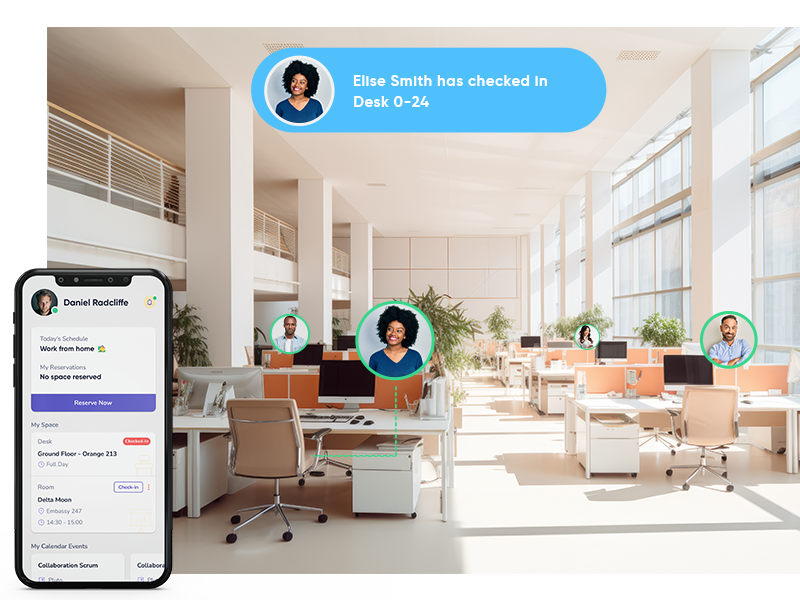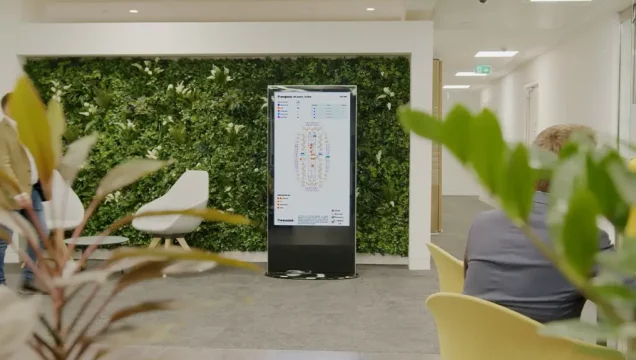

The rise of remote work has transformed the traditional corporate workplace. A recent report by Bloomberg tells us that even three years after the pandemic, hybrid work patterns are still shifting, and Tuesday is now seen as the new Monday. With workers’ habits showing a preference for working from home two days a week, companies are finding it difficult to impose strict return-to-office policies in the face of a persistently competitive job market.
The trend towards fewer employees coming into the office every day of the week has created unique challenges for companies with large workplaces, such as how to manage resources efficiently while still providing an optimal environment for workers. Across our client base, the following trends are most prominent:
- Underutilisation of space: With fewer employees coming into the office, there is a significant amount of unused or underutilised space – increasing the cost per head. This is because the real estate cost exceeds the usage, and companies are often locked into leases, unable to exit them, thus leading to a waste of money.
- Decreased commercial real estate demand: If the trend towards reduced in-person presence in the workplace continues, there will be decreased demand for commercial real estate properties, resulting in lower rental rates or occupancy rates.
- Inefficient resource management: Large workplaces often require a significant number of resources to maintain them, such as heating, lighting. If workspaces are not used to full capacity, then it results in inefficient use of resources, with associated negative impacts on a company’s bottom line.
- Adapting to evolving work patterns: Companies with large workplaces may find it difficult to keep up with changing work patterns, such as flexible hours or remote work, and adjust – which could negatively impact employee satisfaction and productivity.
Many companies are turning to technology and process improvements as a way to maintain operations while also supporting employees. Though investing in operational agility will better prepare for what the future of work holds, the focus needs to be on creating flexible structures that will enable them to respond to the changing needs of their workforce quickly and effectively.
Flexible working arrangements continue to be in high demand in today’s workforce – the statistics speak for themselves, with 62% of employees preferring a mix of in-person and remote work and 63% of employees expecting their employer to offer this kind of flexibility.
So, how can companies create flexible structures to respond better to ever-changing work conditions and workforce needs? With Dynamic Allocation.
Creating Flexible Structures with Dynamic Allocation
With more and more employees working both remotely and as the hybrid model settles in requiring space in the office, organisations need to be able to close spaces on lighter days, or when certain departments or teams are not present, to reduce operational costs.
Dynamic Allocation is a solution that enables Facility Managers to manage and optimise efficiency in utilising the workspaces. The solution combines innovative technologies, such as Freespace workplace sensors and the Freespace Employee Experience App, which gather data on usage patterns to allocate spaces accordingly.
Efficient utilisation isn’t the only benefit to initiating Dynamic Allocation. There are also sustainability benefits, which include:
- Energy savings:
One of the main advantages of Dynamic Allocation is that automated systems can monitor and optimise the use of the workplace in real-time, resulting in lower energy consumption and cost savings. This can include efficient management of power consumption, temperature control, and cooling systems, which can all contribute to a reduction in energy costs.
- Real estate cost reductions:
Real estate cost reductions are a significant benefit of Dynamic Allocation, made possible by automated systems like Freespace Sensors. These sensors can monitor workspace utilisation in real-time, providing valuable data on which spaces are not being used efficiently. With the help of Freespace Analytics, organisations can use this data to reduce the amount of real estate they need to purchase or lease, resulting in significant cost savings.
- Reduction of carbon footprint:
By embracing dynamic allocation and closing unused workspaces on lighter days, organisations can strike a delicate balance between energy conservation and employee comfort. Energy consumption in the workplace is a leading contributor to the carbon footprint, but with Dynamic Allocation, organisations can control and reduce the amount of energy required to maintain the workplace. This reduction in energy consumption, specifically from heating, lighting, and air conditioning, is a step towards reducing the organisation’s carbon footprint and promoting a more sustainable future.

In addition, Dynamic Allocation also simplifies the operations involved in managing space in several ways. They are as follows:
- Hands-off approach for FM:
Dynamic allocation provides a hands-off approach for Facility Management (FM) by automating the allocation of resources to workloads. This eliminates the need for FM staff to manually allocate resources and frees them up to focus on more strategic tasks, such as planning and budgeting.
- Automatic allocation based on usage patterns:
Dynamic allocation simplifies the management of spaces by automatically allocating resources based on usage patterns. The system monitors the usage of resources, such as desks and spaces, and adjusts them based on the needs of the workload. This leads to more efficient use of resources and helps to prevent overloading and other issues that can occur when resources are not allocated properly.
- Increased efficiency and effectiveness:
Dynamic allocation simplifies the management of spaces by increasing the efficiency and effectiveness of workplaces. The system can monitor and control a wide range of factors in real-time and make adjustments as needed. This leads to improved performance, reduced downtime, and other benefits that can help organisations achieve their goals more effectively.
Freespace Employee Experience App: Users Want Simplicity, Companies Want Control
The Freespace Employee Experience App includes several existing features that support Dynamic Allocation. For example, it allows companies to design their workspaces based on:
- Assigned/preferred spaces
- Last checked-in
- Departments
- Flex spaces
- User preferences – like a window seat, quiet place, sit-stand desk, etc.

The Freespace App allows for a seamless and efficient request process for workplace spaces, allowing employees to make their desk/space requests with just two taps. The system then takes care of the rest, ensuring optimal utilisation and effectiveness of the spaces, in alignment with the Facility Manager’s goals.
Need for the Hour: Dynamic Allocation
Freespace technology has the potential to revolutionise good workplace design by providing valuable insights into the utilisation and effectiveness of different types of space. By utilising dynamic planning and analysing real-time data, organisations can validate the return on their investment in office space. This technology allows for the comparison of the performance of multiple types of spaces and usage patterns within a central analytics platform, which can help to refine current workplace layouts and inform the ideation of new office spaces parallelly focusing on the employee experience.
Experience the power of real-time data and dynamic allocation with Freespace – book a demo today.


